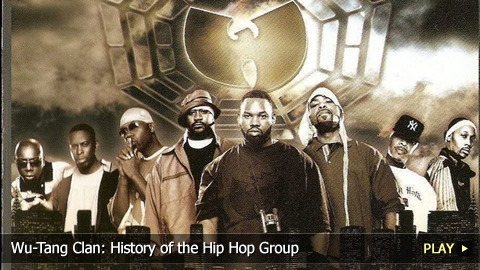Wu-Tang Clan: History of the Hip Hop Group

Early Years
After proving unsuccessful with musical projects like Force of the Imperial Master and All in Together Now, cousins Robert Fitzgerald “RZA” Diggs, Gary “GZA” Grice and Russell Tyrone “Ol’ Dirty Bastard” Jones formed hip hop group the Wu-Tang Clan in Staten Island, New York in 1992. The crew soon welcomed six other local MCs: Clifford “Method Man” Smith, Corey “Raekwon the Chef” Woods, Dennis “Ghostface Killah” Coles, Lamont “U-God” Hawkins, Jason “Inspectah Deck” Hunter and Elgin “Masta Killa” Turner. The group took its name from a 1981 Asian martial arts film.
First Single and Record Deal
The Wu-Tang Clan independently released their first single, “Protect Ya Neck” in the early ‘90s to underground success. This, in addition to tour dates with Cypress Hill, allowed them to negotiate an unprecedented record deal with Loud/RCA: each member had the freedom to record solo albums with different labels.
Debut Album
Consequently, Loud/RCA released their debut Enter the Wu-Tang (36 Chambers) in 1993. With hardcore lyrics, martial arts movie samples and RZA-produced beats, the critically applauded album was eventually certified platinum. It cemented Wu-Tang as one of hip hop’s most influential groups of the decade and contained one of their most successful tracks, “C.R.E.A.M.”
Solo Work
In 1994, the members of Wu-Tang ventured out on their own with well-received solo albums. RZA dropped 6 Feet Deep with side project Gravediggaz, and Method Man followed with solo record Tical, which won him a Grammy for his duet with Mary J. Blige. The next year, ODB released the Grammy-nominated Return to the 36 Chambers: The Dirty Version, Raekwon unveiled Only Built 4 Cuban Linx... and GZA unleashed Liquid Swords. Ghostface Killah made his solo debut with Ironman in 1996.
Wu-Tang Forever
Wu-Tang reconvened the next year to release Wu-Tang Forever. The two-disc effort was a huge achievement as it topped the Billboard 200 chart in its first week and became their most commercially successful album to date. The highly-praised CD earned a Grammy nomination and featured the unconventional lead single “Triumph,” which did not include a chorus.
Work with Outside Artists
They then decided to work with up-and-coming acts associated with the clan. Rappers like Killah Priest, Sunz of Man, Killarmy and Cappadonna all released albums under the Wu-Tang umbrella.
Waning Popularity
Starting in 1998, the members of Wu-Tang spent the next few years releasing solo records. Most of these efforts achieved financial success but received less-than-stellar reviews. The group flooded the market by releasing an abundance of material within a short span, and by promoting the Wu Wear clothing line and the Wu-Tang: Shaolin Style video game.
The W
The Clan’s next album was 2000’s The W. Despite ODB’s absence from most of the album due to his imprisonment for parole violation, the disc premiered at the first position on the Top R&B/Hip-Hop Albums charts and at the fifth position on the Billboard 200. It achieved platinum status and produced the popular radio single “Gravel Pit.”
Iron Flag
Though critics gave 2001’s Iron Flag positive reviews, fans were lukewarm about the record. Consequently, the gold-certified album was one of their lowest-selling efforts.
ODB’s Death
Things soon began to change: Method Man began acting and U-God left following group tensions, though he eventually returned. Then, on November 13th, 2004, Ol’ Dirty Bastard collapsed in Wu-Tang’s New York recording studio. Years of being in trouble with the law and dealing with substance abuse problems had taken its toll on the rapper, who was said to have died from a drug overdose.
Recent Years
The first Wu-Tang Clan release after ODB’s death was 2007’s more experimental album, 8 Diagrams. Surviving members spent the next few years on individual endeavors. However, the rappers still recorded together and even began working on new Wu-Tang material during the next decade.
Legacy
Since the collective jumped on the scene in 1993, rap was never the same: they brought respect to the East Coast, mixed urban lyrics with Asian influences, and created a style all their own. With nine distinct voices, incredible in-house production work and legions of fans, it’s no wonder the Wu-Tang Clan ain’t nothing to mess with.
